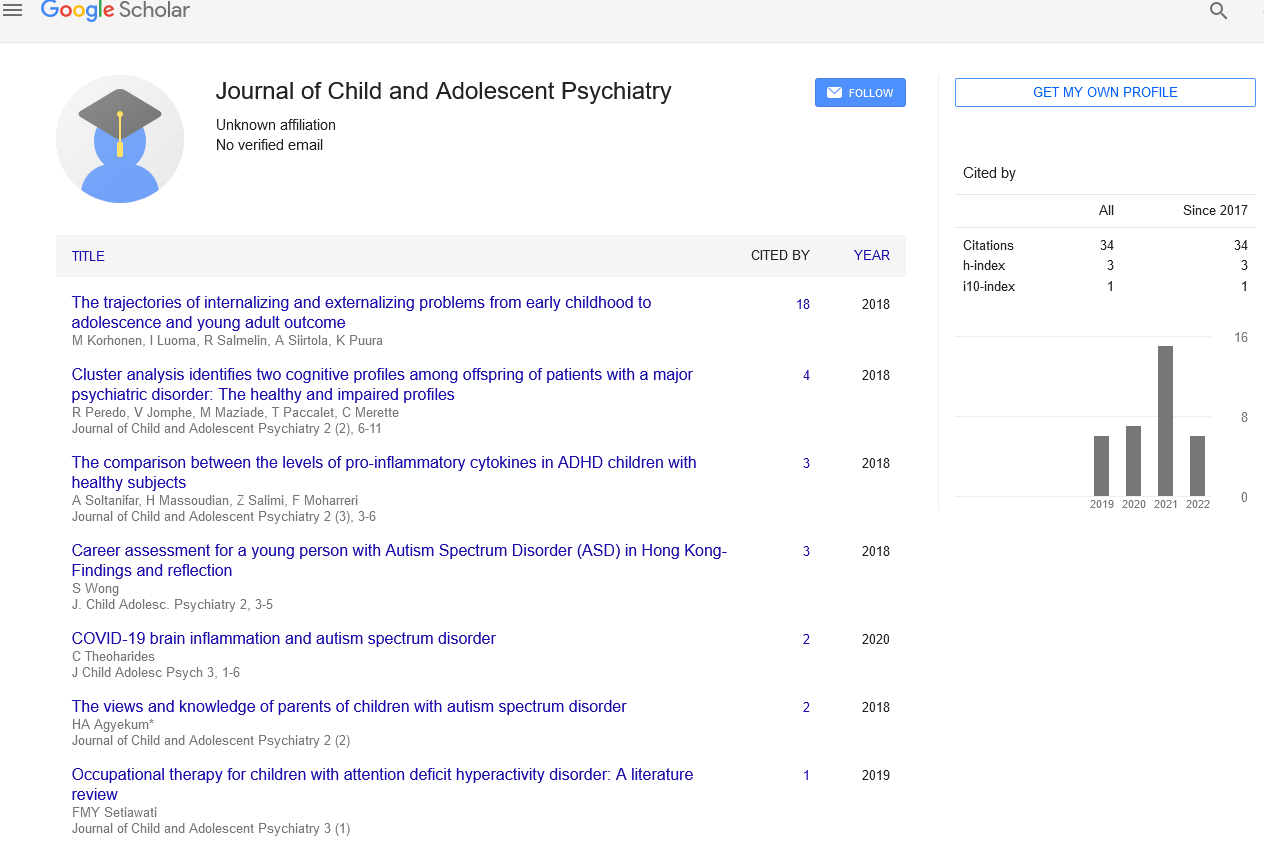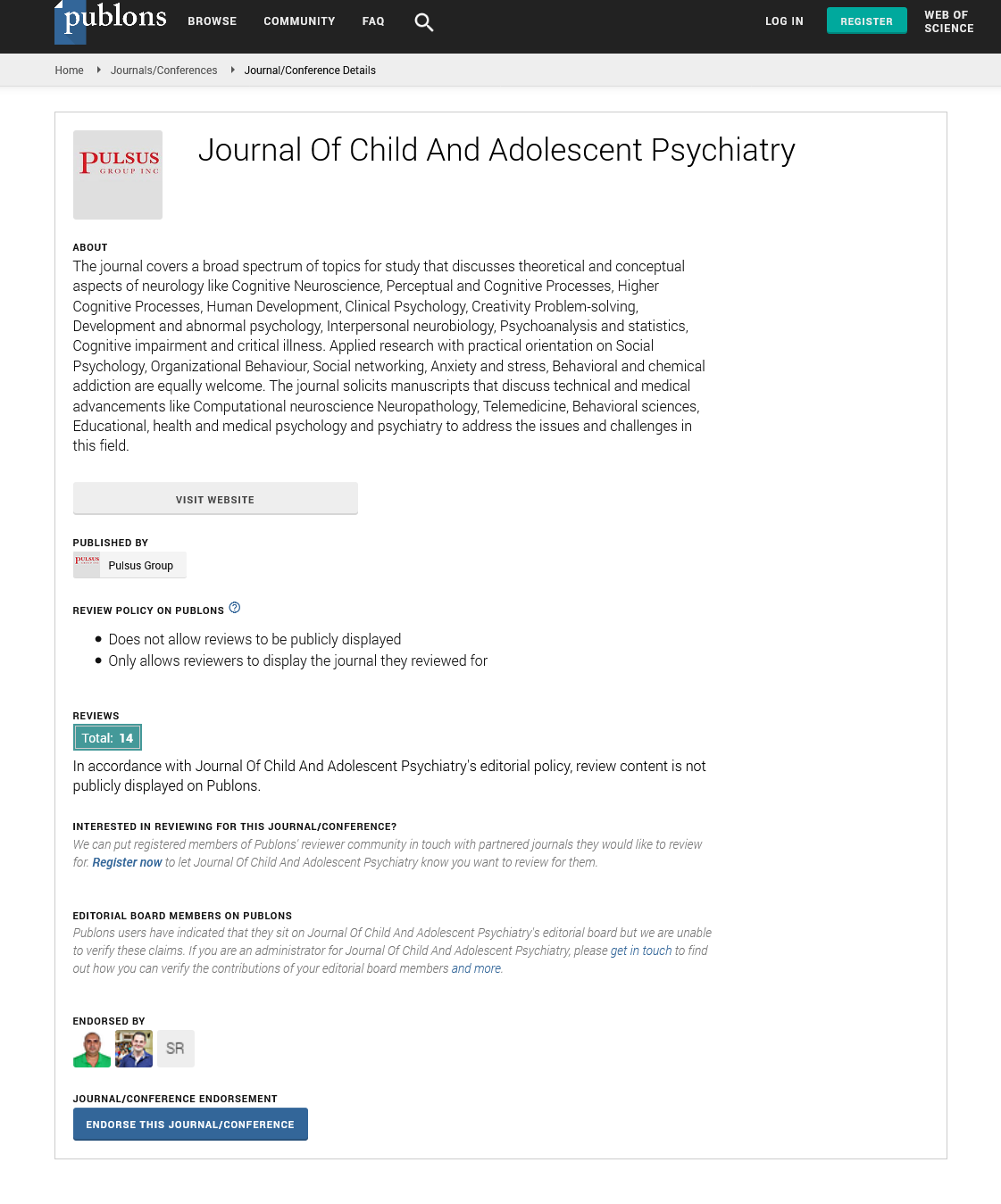A brief study on oppositional defiant disorder and conduct disorder
Received: 16-Sep-2021 Accepted Date: Sep 30, 2021; Published: 07-Oct-2021
Citation: Wang M. An editorial note on anxiety disorders in adolescents. Child Adolesc Psych 2021;5(4):1.
This open-access article is distributed under the terms of the Creative Commons Attribution Non-Commercial License (CC BY-NC) (http://creativecommons.org/licenses/by-nc/4.0/), which permits reuse, distribution and reproduction of the article, provided that the original work is properly cited and the reuse is restricted to noncommercial purposes. For commercial reuse, contact reprints@pulsus.com
Description
Oppositional conduct and direct issues keep on being the most well-known reasons for referral to child and adolescent mental health services. The fundamental provisions of oppositional rebellious confusion (ODD) are an intermittent example of negativistic, defiant, hostile, and disobedient behavior towards authority figures that leads to impairment Conduct disorder (CD) describes more serious aggressive and antisocial behavior. There has been extensive examination with respect to how much ODD and CD are related to each other. Most of the exploration to date upholds them proceeding to be viewed as unmistakable issues.
In addition these behaviors must have been present for at least 6 months and be evident at a level that is developmentally inappropriate (there is subclassification according to age of onset) Caused functional difficulties in a least one domain, there is no requirement that the individual has been charged by the police.
A significant part of the information concerning etiology comes from research on CD as there have been not many studies investigating the causal factors for ODD. Momentum exploration would recommend that none of the elements underneath can be considered as causal, but should be viewed as risk factors. Biological factors
• Studies suggest a familial clustering of ODD, CD, and attention deficit hyperactivity disorder (ADHD), and substance use disorders
• Temperament 'callous-unemotional'
• Autonomic under-excitement, with lower electro dermal movement, and lower mean resting pulse
• Pre-birth or early formative openness to poisons, for example lead
• Exposure to nicotine in utero
• Deficient nutrition and vitamins
• Abnormalities in the pre-frontal cortex
• Changed neural connection work in the serotonergic, noradrenergic, and dopaminergic frameworks
• Low cortisol and elevated testosterone
• Actual sickness particularly those influencing the focal sensory system
Psychological factors
• Connection hardships: likenesses have been noted between the social indications of insecure attachment and disruptive behavioral disorders, but research findings have been inconsistent
• Deficient social learning and information processing
• Reading problems Social factors
• Low socioeconomic status
• Peer relationship difficulties
• Parental mental illness
• Parental substance abuse and criminality
• Parental disharmony, family brokenness including aggressive behavior at home
• Poor supervision by parents
• Actual sickness particularly those influencing the focal sensory system
• Rejection of the child
• Low parental inclusion in the kid's exercises
• Kid abuse, disregard and misuse the most probable circumstance is that will be that ODD and CD arise out of a complex mix of risk and protective factors. There is a lot of discussion concerning which components give assurance and how they may cooperate with risk factors.
• Are defensive factors just something contrary to recognized danger factors, e.g. high knowledge is defensive as low insight builds hazard
• Do defensive components cushion the effect of hazard factors
• Do defensive components cushion the effect of hazard factors outcome
• Do various danger factors collaborate with one another in an added substance or multiplicative ways With respect to the relationship between ADHD, ODD, and CD, longitudinal data suggests that ADHD in early life is an indicator of ODD and CD further down the road, and that this affiliation is frequently mediated by hostile and critical parenting styles. On the other hand, early ODD and CD (in the absence of ADHD) do not predict later ADHD.
Management
Pharmacological interventions Medication should not be the first or only intervention for ODD or CD and should not be started until psychological interventions have been attempted. Psychopharmacological medicines for oppositional or forceful conduct have not been well studied. There have been few double-blind placebo controlled trials with most studies being small scale or open label. Poly pharmacy ought to be stayed away from and cautious checking of consistence and incidental effects is required. Evidence to date would suggest
• In ADHD with co-bleak ODD and CD, energizers and atomoxetine may help diminish oppositionality
• Commonplace and abnormal antipsychotics might help in animosity with regards to mental retardation and pervasive developmental disorders
• Very limited evidence that SSRIs may be helpful for ODD in the context of a mood disorder
• Lithium carbonate has been displayed to diminish animosity and temper upheavals, however contemplates were all conducted in inpatient settings and, therefore, may have limited applicability in outpatient settings.






